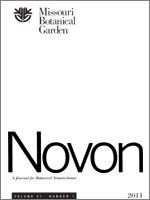The Neotropical genus Posoqueria Aubl. (Rubiaceae) has a number of species with an asymmetric androecium and pollen catapult mechanism and others that apparently lack these features. A new taxonomy based on corolla form and size, the length and symmetry of the filaments, and fruit morphology finds the name P. panamensis (Walp. & Duchass.) Walp. to be a synonym of P. latifolia (Rudge) Roem. & Schult. and distinguishes additional species in southern Central America and northwestern South America, newly described here: P. chocoana C. M. Taylor of wet lowland Panama to northwestern Ecuador has medium-sized corollas, subglobose fruits, corolla lobes of unequal size, and a generally symmetric androecium that apparently lacks the pollen catapult mechanism; P. correana C. M. Taylor of lowland and premontane Panama has medium-sized corollas, leaf blades that are sharply acute at the apex and densely velutinous abaxially, slightly unequal corolla lobes, and a generally symmetric androecium that apparently lacks the pollen catapult mechanism; P. costaricensis C. M. Taylor, found in premontane forests in Costa Rica and Panama, has relatively short corollas (for Posoqueria) and a generally symmetric androecium that apparently lacks the pollen catapult mechanism; P. grandifructa Hammel & C. M. Taylor of lowland Nicaragua and Costa Rica has medium-sized corollas, relatively large, ellipsoid, rough-surfaced, thick-walled fruits, and a generally symmetric androecium that apparently lacks the pollen catapult mechanism; P. longifilamentosa C. M. Taylor of lowland northwestern Ecuador has relatively long corollas and an asymmetric androecium with a pollen catapult mechanism, relatively long unequal filaments, and relatively large anthers; and P. robusta Hammel & C. M. Taylor of lowland Nicaragua and Costa Rica has leathery leaves, relatively long corollas with unequal lobes, subglobose leathery fruits, and a symmetric androecium that apparently lacks the pollen catapult mechanism.
How to translate text using browser tools
7 April 2011
Rubiacearum Americanarum Magna Hama Pars XXVII: Six New Species and a New Taxonomic View of Posoqueria
Charlotte M Taylor,
Barry Hammel,
Roy E Gereau
ACCESS THE FULL ARTICLE
Colombia
Costa Rica
Ecuador
Henriquezieae
IUCN Red List
Ixoroideae
Nicaragua





